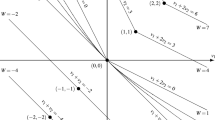Abstract
A social welfare function satisfies Bounded Response if the smallest change in the variable (i.e., preference profile) leads to the smallest change, if any, in the value (i.e., social preference). We show that each social welfare function on each connected domain satisfies Bounded Response and a nonmanipulability condition if and only if it satisfies a monotonicity condition and independence of irrelevant alternatives. Moreover, under Bounded Response, we show the equivalence of various notions of nonmanipulability of social welfare functions.

Similar content being viewed by others
Notes
See, for example, Young (1995) for arguments supporting IIA.
Let \(f\) be a social welfare function and \(X\) a set of all alternatives. For each preference profile \(\varvec{R}\) and each set \(A\subset X\), let \(F(\varvec{R}, A)\) be the first ranked alternative in \(A\) according to \(f(\varvec{R})\). Then, \(F(\cdot , A)\) is a social choice function on \(A\), and we say that \(F(\cdot , A)\) is derived from \(f\).
Bossert and Storcken (1992) assume that the number of alternatives is at least \(4\). Additional properties are nonimposition and weak extrema independence for even number of agents, and nonimposition and extrema independence for any number of agents.
A binary relation \(T\) on \(X\) is a subset of \(X\times X\). For each pair \(x, y\in X\), we write \(x~T~y\) for \((x, y)\in T\). A binary relation \(T\) is complete if for each pair \(x, y\in X\), either \(x~T~y\) or \(y~T~x\), transitive if for each triple \(x, y, z\in X\), [\(x~T~y\) and \(y~T~z\)] imply \(x~T~z\), antisymmetric if for each pair \(x, y\in X\), [\(x~T~y\) and \(y~T~x\)] imply \(x = y\). A binary relation is called a linear order if it is complete, transitive, and antisymmetric.
See footnote 3 for the definition of derived social choice functions.
Sato (2013) shows that on a connected domain, each social choice function is strategy-proof if and only if it is nonmanipulable by preferences which are adjacent to the true preference.
\(f\) is Agreement Manipulable because \(f(R_i^3, \varvec{R}_{-i})\) agrees more with \(R_i^1\) than \(f(R_i^1, \varvec{R}_{-i})\). To see Adjacency-restricted Agreement Nonmanipulability, consider the case \(R_i =R_i^1\). In \(\mathcal {D}\), only \(R_i^2\) is adjacent to \(R_i\). Because \((y, z) \in ( f(R_i^1, \varvec{R}_{-i})\cap R_i^1)\) and \((y, z)\not \in (f(R_i^2, \varvec{R}_{-i})\cap R_i^1)\), \(( f(R_i^1, \varvec{R}_{-i})\cap R_i^1) \subsetneq (f(R_i^2, \varvec{R}_{-i})\cap R_i^1)\) does not hold. Similar arguments hold in the other cases \(R_i =R_i^2\) or \(R_i = R_i^3\). Thus, \(f\) is Adjacency-restricted Agreement Nonmanipulable.
References
Arrow KJ (1963) Social choice and individual values, 2nd edn. Wiley, New York
Barberà S (2010) Strategyproof social 731choice. In: Arrow KJ, Sen A, Suzumura K (eds) Handbook of social choice and welfare, Chap. 25, vol 2. North-Holland, Amsterdam, pp 731–831
Baigent N (1987) Preference proximity and anonymous social choice. Q J Econ 102:161–169
Black D (1948) On the rationale of group decision-making. J Polit Econ 56:23–34
Blair Douglas, Muller Eitan (1983) Essential aggregation procedures on restricted domains of preferences. J Econ Theory 30:34–53
Bossert W, Sprumont Y (2014) Strategy-proof preference aggregation. Games Econ Behav 85:109–126
Bossert W, Storcken T (1992) Strategy-proofness of social welfare functions: the use of the Kemeny distance between preference orderings. Soc Choice Welf 9:345–360
Gibbard A (1973) Manipulation of voting schemes: a general result. Econometrica 41:587–601
Kemeny JG (1959) Mathematics without numbers. Daedalus 88:577–591
Kemeny JG, Snell JL (1962) Mathematical models in the social sciences. Blaisdell, New York
Moulin H (1988) Axioms of cooperative decision making. Cambridge University Press, Cambridge
Sato S (2013) A sufficient condition for the equivalence of strategy-proofness and nonmanipulability by preferences adjacent to the sincere one. J Econ Theory 148:259–278
Satterthwaite MA (1975) Strategy-proofness and Arrow’s conditions: existence and correspondence theorems for voting procedures and social welfare functions. J Econ Theory 10:187–217
Young P (1995) Optimal voting rules. J Econ Perspect 9:51–64
Author information
Authors and Affiliations
Corresponding author
Additional information
I am grateful to the Associate Editor, anonymous reviewers, Arunava Sen, William Thomson, and participants at GCOE International Conference on Equality and Welfare 2013 at Hitotsubashi and Mathematical Economics Seminar at Keio for helpful comments. This work is supported by JSPS KAKENHI 25780142.
Rights and permissions
About this article
Cite this article
Sato, S. Bounded response and the equivalence of nonmanipulability and independence of irrelevant alternatives. Soc Choice Welf 44, 133–149 (2015). https://doi.org/10.1007/s00355-014-0825-8
Received:
Accepted:
Published:
Issue Date:
DOI: https://doi.org/10.1007/s00355-014-0825-8



